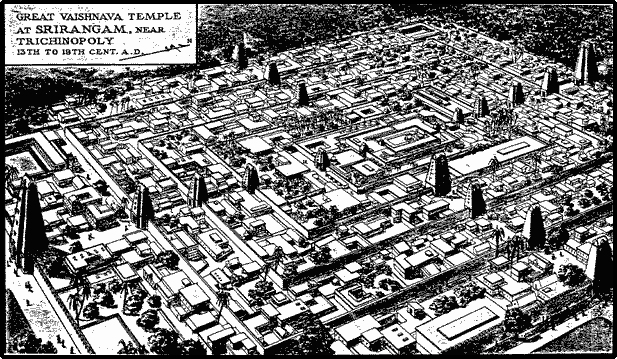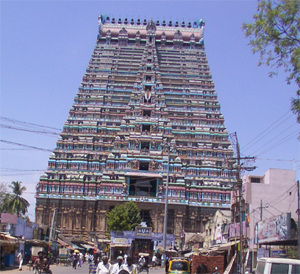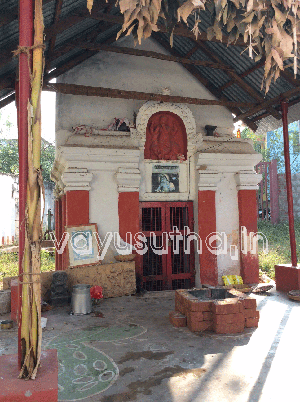
Srirangam and Sri Ranganatha Temple
Srirangam in Tamil Nadu near Trichy is the first among the one hundred and eight Divya Desams. Out of the twelve Azhwars, eleven Azhwars had sung in praise of the presiding deity Sri Ranganathar of this kshetra. For the worshippers of Sri Hari ‘koyil’ means only this kshetram. The temple complex is as big as the city itself, and the architecture of the complex is so, that the main deity is enclosed in seven ‘chutru’. The revered temple was the epicenter of dwita philosophy and has a long history.
 Sriranga Mahathmiyam brings out in detail the origin of the great temple in Srirangam in Tamil Nadu. Brahma meditated upon Sri Vishnu and in His supreme trance received the gift of Vishnu's deity, "Ranga Vimana". The deity was in worship at Ayodhya after being passed on by Brahma to Viraja, Vaiswatha, Manu, Ishwaku, and finally to Sri Rama. Since the deity “Ranga Vimana” was in worship by the dynasty of Ishwaku He is known as ‘Kula Dhanam’ . Sri Rama worshipped the deity for a long time at Ayodhya and gave the same to the King of Lanka Sri Vibhishana. When Vibhishana was going via Trichy en route to Sri Lanka, the deity wanted to stay in Srirangam. Ranganathan, captivated by the devotion of a King called Dharma Varma, who was doing penance to have Lord Ranganathan permanently stay at Srirangam, stayed put, promising to cast his benign glance eternally on Lanka. Hence the deity (in a reclining posture) faces south towards Lanka.
Sriranga Mahathmiyam brings out in detail the origin of the great temple in Srirangam in Tamil Nadu. Brahma meditated upon Sri Vishnu and in His supreme trance received the gift of Vishnu's deity, "Ranga Vimana". The deity was in worship at Ayodhya after being passed on by Brahma to Viraja, Vaiswatha, Manu, Ishwaku, and finally to Sri Rama. Since the deity “Ranga Vimana” was in worship by the dynasty of Ishwaku He is known as ‘Kula Dhanam’ . Sri Rama worshipped the deity for a long time at Ayodhya and gave the same to the King of Lanka Sri Vibhishana. When Vibhishana was going via Trichy en route to Sri Lanka, the deity wanted to stay in Srirangam. Ranganathan, captivated by the devotion of a King called Dharma Varma, who was doing penance to have Lord Ranganathan permanently stay at Srirangam, stayed put, promising to cast his benign glance eternally on Lanka. Hence the deity (in a reclining posture) faces south towards Lanka.
Contributions to Sri Ranganatha Temple - Srirangam
Almost all the kings who had ruled south India had contributed towards the development of this temple. Many villages were given as gifts for the daily poojas being performed and also for the festivals that are conducted in this temple. Many ornaments were given as a gift to the deities of this temple. Thus the temple complex had become a city by itself and the deity one of the richest in the country.
Malik Kafur in Srirangam
Srirangam has a glorious history right from the days when the temple town was under the rule of Dharma Varma. In modern times, one cannot forget Malik Kafur ransacking the city, and paving the way for the Delhi Sultanate to follow.
Malik Kafur (1296-1316) was a eunuch slave who served as the general in the army of Alauddin Khilji, ruler of the Delhi Sultanate from 1296 to 1316. He was responsible for the Delhi Sultanate extending their kingdom beyond the Vindhya Range. He had not only brought rulers of the South under the Delhi Sultanate, but he was also a person who had plundered the wealth of temples, the public, and the rulers of the South. His act of destroying the Hindu temples of the South is well recorded in History. Srirangam is no exception to his vandalism. After appointing a representative of the Delhi Sultanate in the territories he owned in the South, he left for Delhi with the loot.
According to Muslim historian Jiauddin Barani, Malik Kafur went back to Delhi with 241 tons of gold, 20000 horses, and 612 elephants laden with the looted treasure.
Namperumal
The utsava murti of Sri Ranganatha Swamy is known by the name Namperumal. While south India was in the spade of invasion by Malik Kafur, devotees of Sri Ranganatha had made a make-believe temple of the deity, and had taken away the Namperumal to a safer place. Namperumal had to travel in hiding through safer areas, but the devotees who had accompanied the deity performed all the poojas during this journey. Namperumal was away from the moolavar at Srirangam from the year 1322 and returned to Srirangam in the year 1371 only after tranquility returned to Srirangam under the Vijayanagar rule.
Vijayanagara Samrajya
The Vijayanagara Empire was established in 1336 by Harihara I and his brother Bukka Raya I in the Deccan Plateau region in South India as its base. The empire rose to prominence as a culmination of attempts by the Southern powers to ward off Islamic invasions by the end of the 13th century. The empire founded by Harihara and Bukka was supported and inspired by H.H. Sri Vidyaranya, Sankaracharya of the Sringeri mutt to fight the Muslim invasion of South India. This dynasty was known as the Sangama Dynasty. They had conquered the entire south India and appointed their representative known as ‘Mandaleswarar’ to rule on their behalf.
All the Mandaleswarars appointed by the empire were restoring the temples and were re-inculcating unity among the followers of Sanatana Dharma.
Change of political scene
The power of the empire was usurped from the Sangama dynasty emperor Praudha Devaraya by one of the Madaleswar Saluva Narasimha Deva Raya in the year 1485. In 1486 he declared himself as the emperor and a new dynasty namely Saluva was in control of the empire.
Konerirayan of Tamilnadu
On seeing that a mandaleswar had become an empire, many mandaleswars who were loyal to the Vijayanagar Samrajya till then had declared independence and started to rule the territory of their own. Notable among them are Konerirayan and Mabali Vaanaatirayan in the Tamilnadu region.
Srirangam was under the rule of Konerirayan and had made many contributions to this temple at Srirangam and the temple at Tirupati. Although he is a Shivate he had love for Vaishnavism also.
Due to the compelling political reasons and the change of guard at Vijayanagar from the Sangama dynasty to the Tuluva dynasty, the then emperor Tuluva Narasa Nayaka fought a war against Konerirayan in the year 1496 and Narasa Nayaka took over Srirangam.
Narasa Nayaka’s brother Kanthadai Ramanujar, a Bairahi saint was in Srirangam. He asked his brother Narasa Nayaka to intervene in the affairs that were under the control of Konerirayan. It was at his invitation to intervene in the administration of the temple, Narasa Nayaka, the karyakarta of the Emperor of Vijayanagar had invaded and won the territory of Konerirayan.
Dispute of Srirangam and Tiruvanaka
 It is said that in the past, it was customary that during the annual Brahmotsavam, Namperumal—Utsava murti of Sri Ranganatha would visit His sister Sri Akiladeswari Ambal at Tiruvanaika, rest for a while at the mandapam near the entrance of Tiruvanaika temple, and return to Srirangam.
It is said that in the past, it was customary that during the annual Brahmotsavam, Namperumal—Utsava murti of Sri Ranganatha would visit His sister Sri Akiladeswari Ambal at Tiruvanaika, rest for a while at the mandapam near the entrance of Tiruvanaika temple, and return to Srirangam.
During the invasion of Malik Kafur Nam Perumal was away from the temple. After about 50 years, Sri Ranganatha Uttsavar (Nam Perumal) returned to Srirangam in the year 1371. After nearly ninety years of absence, the practice of Namperumal visiting Tiruvanaika was to be restored but there was resistance to the revival of this practice. From then on there was a dispute between Srirangam and Tiruvanaka, regarding jurisdiction.
Despite mediation efforts the dispute continued...
Sri Vyasaraja offered a solution to this vexing problem which was cropping up again and again. He stated that he would hold his breath and walk in each of the four directions from the main garbhagraha of Sri Ranganatha. Wherever he stops holding his breath, that spot will be marked as the boundary of Srirangam.
Sri Vyasaraja
Sri Vyasaraja was a great saint of that time and a follower of the Dwita philosophy of Sri Madvacharya. He was the Rajaguru for both the Saluva and Tuluva dynasties of Vijayanagaram. He was instrumental in the renovation of many temples that were destroyed during the onslaught of Malik Kafur. He was a great devotee of Sri Hanuman and had built many temples for Sri Anjaneya.
More about him in our site Sri Hanumath Devotees - Sri Vyasaraja ”
Continued dispute - solved?
Sri Vyasaraja was the Rajaguru of the Vijayanagara Empire and was on a visit to Srirangam. When on such a visit the dispute over the boundary between Srirangam and Tiruvanaka was brought to his notice. He offered a solution to this vexing problem which was cropping up again and again. He stated that he would hold his breath and walk in each of the four directions from the main garbha graha of Sri Ranganatha. Wherever he stops holding his breath, that spot will be marked as the boundary of Srirangam.
As said he walked in all directions and determined the boundary of Srirangam.
Ellaikarai - Boundary
It is customary for Vijayanagara to mark the boundary of villages with a temple for Sri Anjaneya. With no exception, Sri Vyasaraja who was also a devotee of Sri Hanuman had built four Hanuman temples at these four places marked as the boundary of Srirangam. Today three of them are in existence and one at ellaikarai mandapam had been removed over time.
 On the eighth day of the annual celebration, Namperumal visits the other ellaikarai of Srirangam on the banks of Kollidam River. This is northeast of Sri Ranganatha temple. There is a mandapam at this ellaikari and Sri Ranganatha comes in a palanquin here on the eighth day and returns to His temple in an Equestrian [horse] vahanam via Kollidam River. The mandapam at this place is known as ‘Ellaikarai mandapam’ . This is part of the practice as mentioned in the above paragraphs but without the visit to Tiruvanaika.
On the eighth day of the annual celebration, Namperumal visits the other ellaikarai of Srirangam on the banks of Kollidam River. This is northeast of Sri Ranganatha temple. There is a mandapam at this ellaikari and Sri Ranganatha comes in a palanquin here on the eighth day and returns to His temple in an Equestrian [horse] vahanam via Kollidam River. The mandapam at this place is known as ‘Ellaikarai mandapam’ . This is part of the practice as mentioned in the above paragraphs but without the visit to Tiruvanaika.
There is no temple for Sri Hanuman found nearby here.
The first Hanuman temple is in Srinivasa Nagar near the Railway overbridge. This is southeast of Sri Ranganatha temple. The second one is on the banks of river Kavari in Amma mandappam road which is south of Sri Ranganatha temple. The third one is in Melur road about three kilometers from Srirangam which is North West of Sri Ranganatha temple.
There are the two places that are presently known with the prefix ‘Ellaikarai’ indicating that these points were once used as a demarcation of the territory of the Srirangam town. The first one is Ellaikari mandapam and the second is Ellaikarai Anjaneya temple at Srinivasa Nagar.
Ellaikarai Anjaneya Temple
The temple in Srinivasa Nagar near the Railway overbridge is known as Ellaikari Anjaneya Temple which is under the control of Sri Vyasaraja Mutt of Srirangam. This is southeast of Sri Ranganatha temple.
It is a small west-facing temple cum garbhagraham of Lord Anjaneya. There is a well-ornated vimanam with a kumbam over the garbhagraham.
Sri Anjaneya Swamy
The deity of Lord Ellaikarai Sri Anjaneya Swamy of Srirangam is about two feet tall and made of hard granite stone. He is in a walking posture and the carving is of ‘ardha shila’ type. Lord is seen walking southward with His left lotus foot adorning Nupur and thandai in the front. His right lotus foot is seen slightly raised from the ground. His left-hand adorning bracelet is seen resting on the left hip and in his hand, he is holding the stem of the sowgandika flower. The flower that is in a half-blossom state is seen above His left shoulder. He is wearing ornaments which adorn His bosom. With His other hand raised above He showers blessings on His devotees. The tail of the Lord is raised above His head with a curved end that adorns a small beautiful bell. The Lord is wearing ear studs which are touching his shoulders and His kesam is neatly tied. His eyes are glowing and emitting karuna on the devotee.

Balalayam for Srirangam Ellaikarai Anjaneya temple was performed by H.H. Sri Vidyasrisatirtha on 14.01.2023. The renovation was completed, and the temple was opened on July 12, 2024. The above image of the renovated temple is from Sri Vyasarajamatha's announcement of the inauguration.
Location of the temple: "Ellaikarai Anjaneya Temple, Srirangam"
Experience
With bright glowing eyes Lord Anjaneya of the Kshetra is a figure to be meditated upon. His presence can be felt in this kshetra and is so powerful and peace will descend on you when meditate here.
SRI HANUMAN THINKS DIFFERENTLY, THINKS FAST
THINKS AHEAD AND ACTS FOR SURE
Ed [March 2016]
Updates: [Jan 2025]
